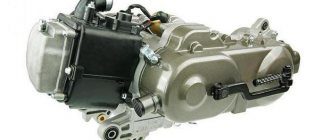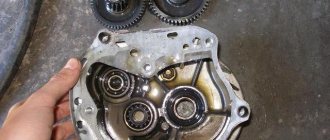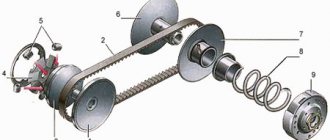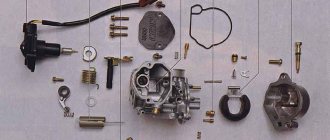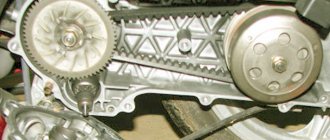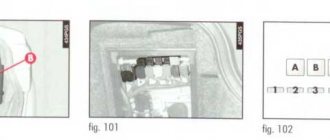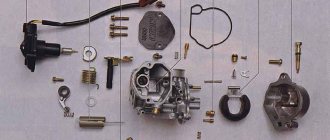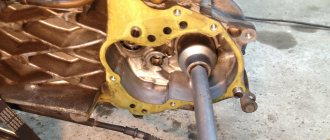Varieties of the 139 qmb engine
Displacement of an internal combustion engine.
Although Chinese scooters have been imported to Russia for more than eight years, to this day no one really knows what engine displacement is on their scooter. Some sellers themselves do not know what they are “pushing” to unlucky buyers. In most cases, what is written on the packaging box is what is told to the consumer. In fact, knowing the exact volume of your internal combustion engine is not so unimportant. For example, if you are tuning your favorite scooter, then this is simply necessary for you to further calculate the compression ratio and select the fuel (AI-92, AI-95, AI-98) on which your pet will ride. Many people don’t think about this, but due to the wrong choice of fuel, valves burn out, pistons burn out, muffler rings and partitions crumble, and now you’re in the workshop, and not on a beautiful country highway. To avoid all these problems, you need to know the following formula:
Using this formula, you can calculate the displacement of any engine. Once we know the engine displacement, we can correctly calculate the compression ratio and select the required octane number of fuel for your scooter.
In the previous article (Calculating the working volume of an internal combustion engine), we told how to correctly calculate the working volume of the engine, hereinafter V-slave.
Formula for calculating the compression ratio
Σ = (Vwork + Vks) / Vks
The compression ratio should be: AI-92: from 9.5 to 10.5 AI-95: from 10.5 to 11.5 AI-98: from 11.5 to 13
Scooter engines: review of Chinese models 139QMB and 157QMJ and D1E41QMB
Scooter engines: review of Chinese models 139QMB and 157QMJ and D1E41QMBDespite all the variety and variety of Chinese scooters on Russian roads, their engines belong to only two categories. This is a two-stroke scooter engine and a four-stroke one.
These categories differ greatly in the number of models produced, so let's start with the largest category - the 139QMB four-stroke scooter engine. Its history began at the end of the last century, when in the 90s the Honda branch developed the first such scooter engine model, and today it is called KYMKO. Ten years later, China adopted this development and, together with Honda, began mass production. How good the final version turned out can be judged by the fact that scooter engines labeled 139QMB are regularly purchased from Japan and sold there under the Honda brand.
The 139QMB scooter engine has already become a legend in the motorcycle world, and Hongling Corporation, which officially produces it, installs this engine not only on motorcycles of its own brand, but also successfully sells them for assembly at prices of other motorcycle brands. The recognition of this scooter engine is simply colossal: the marking is located on the left side of the crankcase. The serial number begins with 139QMB, followed by the product number in the production batch.
The 139QMB scooter engine is practically flawless, it can be treated with some degree of carelessness or negligence (but, of course, in moderation). The warranty usually covers the first 5 thousand kilometers. This distance is necessary for the scooter engine to allow grinding in of all its units and components. Once the initial parameters are passed, the lifespan of which the 139QMB scooter engine is capable is about another 20 thousand kilometers. And this is at an average speed of 90 km/h. The engine power is more than enough for a full-size 2-seater scooter.
Some Chinese corporations decided not to look for easy ways and created their own unit. This scooter engine is marked 1P39QMB, and in terms of its external characteristics it is an exact copy of 139QMB. But if you look in more detail, the differences are clearly striking. The 1P39QMB scooter engine is assembled without adjusting the clearances in all valves. The same negligence can be seen in the carburetor, which requires mandatory adjustment and cleaning before starting. In the hands of an experienced scooter rider, the engine will, of course, work, but its main purpose is to make the scooter even less expensive. All budget options that are good for several trips are equipped with just such engines.
The engine of the scooter model 1P39QMB will not have proper dynamics if it has not been run in before use. Only after 2 thousand kilometers does it enter the optimal phase of operation, but after 10 thousand kilometers its performance drops sharply.
The 157QMJ scooter engine models can be produced in two volumes - 150 and 125 cc. see. They are installed on more expensive scooters “BM”, “Honling”, “Forsazh” and others. In terms of reliability and functionality, the 157QMJ scooter engine is an absolute copy of the 139QMB. Also, many design details in it are reminiscent of mass-produced Japanese analogues.
The service life of such engines is already an order of magnitude higher and amounts to 25 thousand kilometers. It has powerful acceleration coupled with very high speed. Their main drawback (if this can be considered a drawback) is their higher cost compared to the previous model. But having bought a 157QMJ scooter engine once, this purchase will serve faithfully for many years, without requiring major intervention in its operation.
There is only one two-stroke scooter engine made in China. Its model is D1E41QMB. It has a chain reverse gear, which fundamentally distinguishes it from all other representatives of this class of units. Reliable operation of such a scooter engine is achieved by adding
Chinese scooter: we tune the gearbox
Chinese scooter: tuning the gearbox Quite often, motorcyclists, when tuning their scooter, want to add an increase in top speed to the increase in dynamic parameters. The coveted figure is another plus 20 km/h, and to achieve it, you can go in two ways. The first option is to rev the engine to more powerful speeds, the second is to replace the gearbox. As for the first option, it may seem simpler at first glance, although it has several important nuances. In order for the engine to work as long as it should and not to run out of steam ahead of time, it is necessary to purchase all the spare parts for Chinese scooters of very high quality, since they will have to withstand additional overloads for a long time and still function effectively.
We will be looking at tuning a scooter that has a 139QMB engine, so this option will not be suitable for everyone because it is quite expensive. A simpler and cheaper way to increase the maximum speed limit in this case would be to simply replace the gearbox with a more powerful one.
The functions of the gearbox are to reduce the speed generated by the variator, increase torque, and also directly transmit it to the rear wheel. A gearbox is a whole set of gears and shafts, where each gear contains a clear number of teeth. Their configuration was invented by experienced engineers, taking into account all aspects of operation and the cubic capacity of each model, so the efficiency of the scooter is considered optimal at any speed range. And spare parts for Chinese scooters, purchased as a set, only enhance the comfort and safety of riding.
As soon as the piston is increased, the gear ratio produced by the gearbox already becomes “short”, so it can be considered irrelevant. This leads to the fact that accelerating to 50-60 km/h becomes much easier and faster. Moreover, a scooter with a passenger will be more stable than a model equipped with a stock piston. But it will not be possible to achieve the coveted increase in speed in this way, since the engine speed remains the same.
Only a complete replacement of the gearbox will help solve this situation and achieve the desired result. You can carry out the procedure for replacing all the gears yourself by purchasing all the necessary spare parts for Chinese scooters in the store. And, of course, the speed will increase. But the dynamics of other indicators will remain the same as they were before. Therefore, when starting to replace, everyone must think for themselves and decide for themselves what is more important: dynamics or speed indicators. It is quite difficult to achieve improvements in all of these indicators at once. You will have to fine-tune the entire variator in conjunction with the engine.
Of course, if the budget allocated for tuning allows for more expensive manipulations, then why not. Every desire of a scooterist, supported by financial capabilities, must be fulfilled.
How to increase the top speed of a Chinese scooter (139QMB engine)
To increase the top speed of a Chinese scooter, it is necessary to carry out a number of manipulations:
Replace the stock piston (volume 50 cc) with a tuned one (volume 82 cc). The piston diameter will be 5 cm. The carburetor must also be adjusted. Replace all old gearbox gears. The stock 139QMB engine has two gears with a gear ratio of 0.29, as well as 15X52 tooth gears. Gears with a gear ratio must be replaced with more powerful ones, then the gear ratio will increase to 0.35. We replace the remaining gears with 17x49, and as a result we get a +20% increase in the speed limit of the scooter. Most online stores have already taken care of their customers and put ready-made gearboxes on the shelves, where the gear is already installed on the intermediate shaft, so all that remains to be done is to replace the old motorcycle parts with new ones. Replace the factory variator with a more powerful one. By performing such a manipulation, it will be possible to achieve uniform tension
construction of a V-belt variator for a scooter
A more correct formulation for the technical characteristics of the scooter transmission would be the following: “automatic continuously variable.” In fact, we are talking about such a type of transmission as a V-belt variator, which appeared quite a long time ago, but due to its characteristics, it received the greatest development on scooters, as well as on snowmobiles.
The design of such a transmission is much simpler than a classic manual gearbox, and even more so than the notorious “automatic machines” that cars are equipped with (by the way, some representatives of the four-wheeled world also have a CVT, but a different one than on scooters). It is very simple to understand how a variator works if you remember the system for changing gear ratios on bicycles: several sprockets in front, several in the back, and they are connected by a chain.
Design of a scooter's V-belt variator For a more complete understanding of the process, let's see how the scooter's variator behaves under different engine operating modes. At idle speed, the drive pulley speed is variato
Source
Preparation
So that you don’t have green snot later about the fact that the tuning piston does not fit into the crankcase and you were allegedly deceived here - remove the old piston from the engine and measure the hole for the liner with a caliper. If the hole is smaller than the tuning piston sleeve, the “meat” of the crankcase allows it, hands grow from where it is needed - a round file will help you (only before boring - disassemble the engine, assemble the empty crankcase with bolts, bore the hole, make sure that the piston enters the crankcase without problems - wash the parts from shavings and reassemble the engine. Or, as a last resort, coat the crankcase and file with grease to at least somehow protect yourself from sawdust getting into the inside of the engine.)
The hole for the 162QMK engine sleeve (such engines are installed on Chinese scabs, more popularly known as “Leika”) in stock is 65 mm. Without boring, a piston of 57mm (150CC), 61mm (1700CC) and 62mm (180CC) easily fits into this crankcase. You won’t find a 62mm piston on sale during the day, so it was decided to install a regular 61mm piston on this engine.
By the way, for those who do not know, a piston with a diameter of 61 mm can be easily installed not only on the Leica engine, but also on any other Chinese 150 equipped with a 157QMJ series engine. There, if you put your hands to it, you can stick a piston at 62mm, but only if the “meat” of the crankcase allows it. Everything is individual, you need to look at the place. In any case, the distance along the studs is the same for both the 61mm piston and the 62mm piston.
From left to right: 61mm, 57mm
On the 139QMB series engine from a regular Chinese 80-six, you can easily install a piston 39mm (45CC), 47mm (72CC), 50mm (84CC)
From left to right: 39mm (45CC), 47mm (72CC), 50mm (84CC)
Engine Features
The official manufacturer of the 139QMB scooter engine is Hongling Corporation, which equips motorcycles not only of its own brand, but also of other brands with this engine.
The corporation sells power units to other manufacturers. The motor itself is very recognizable: the design features of the 139QMB engine and its markings on the left side of the crankcase immediately make it clear what kind of heart beats the scooter.
The motor has no flaws, does not require special treatment and calmly tolerates minor negligence and negligence. The manufacturer provides a guarantee for its products that covers the first 5 thousand kilometers. This mileage is enough for the new 139QMB 4t scooter engine to fully run in and grind in all elements and components of the systems.
The total service life of the engine is about 20 thousand kilometers, with the exception of 5 thousand running-in at an average driving speed of 90 km/h. The technical characteristics of the 139QMB engine are not bad: its power is enough for a two-seater full-size scooter.
Specifications
| Release | 2019 |
| Colors | Great choice |
| Engine capacity | About 150 cm.3 |
| Speed | Up to 90 kilometers per hour |
| Power | 9.5 hp |
| Muffler | Material aluminum |
| Motor | Japanese four stroke |
| Transmission | Presented with automatic variator |
| Brakes | Disc version |
| Ignition | Electronics |
| Cylinders | 1 PC |
| Fuel supply | Carburetor |
| Used | AI 92 |
| Start | Kickstarter |
| Transported cargo | No more than 150 kg |
| Cooling | Air force |
| Tires | R-13 |
| Frame | Steel pipe |
| Steering wheel | Rubberized handles |
| Weight | 112 kg |
| Seats | Spacious for 2 people |
| Optical system | 2 mirrors |
| Mirror housing | Durable aluminum |
| Signaling | Audio system, triggered by a mobile phone call |
| Shock absorber | 2 |
| Front suspension | Telescopic fork |
| Rear suspension | Rocking fork |
| Dimensions | 1880/700/1170 (l-w-h) |
The characteristics are quite satisfactory for scooter lovers. The equipment is good.
The scooter has good equipment
Motor characteristics
The Vulcan scooter engine is 150cc four-stroke.
Speed up to 90 km/h. When replacing parts, refer to the markings. Write it down before using it.
Numbers and Latin letters are stamped in two places on the engine:
- on the crankcase under the front variator cover, at the bottom;
- near the gearbox on the engine crankcase.
We find spare parts by markings.
There are 2 markings:
- 139QMB;
- 1P39QMB.
- The number 1 denotes 1 cylinder, P - its horizontal position. If there is no “P”, then horizontal placement is not necessary;
- The numbers “32”, “52” indicate the internal diameter of the cylinder and piston;
- “F” - air flow cooling of the motor (1P39FMB);
- “Q”—forced cooling. A blower casing is installed, if there is no letter - water cooling (139FMB, 152QM), (172MM);
- “M” - motor type (139QMA) motorcycle;
- The third letter volume is “A” 50, “B” 70, “J” 150-155.
The Vulcan 150 model has a “J”.
The key to a long service life of a scooter is high-quality running-in
Exploitation
There are 2 periods: run-in and normal.
It is necessary to break in a scooter after purchasing a new one or after repairs have been carried out. The parts and gaskets are grinding in and the motor is in thermal mode. High-quality running-in is the key to long service.
- A smooth, level road with a dense surface is selected; crushed stone is not suitable;
- the speed limit is set to medium, 60-70 km/h;
- you cannot overload the engine, transport heavy loads, ride with a second person, or climb a hill;
- warm up the engine before driving;
- running-in duration is 1000 km;
- Do not switch modes abruptly.
Up to 150 km:
- do not allow the engine to operate for long periods of time with the throttle handle turned more than 1/3 of a revolution;
- stop every 10 minutes to cool the engine;
- Change speed frequently.
After purchasing new equipment, it should be run in
after 150-500 km:
- you need to wash the filter and change the oil;
- Turn the throttle handle ½ turn for a short time.
500-1000 km;
- briefly turn the handle ¾ turn;
More than 1000 km:
- turn the handle completely.
For all modes, change the speed periodically.
While warming up, monitor the rotation of the crankshaft. Rapid rotation will cause jamming.
There are few fans of winter driving. When storing the scooter, drain the gasoline. In cold weather, the fuel changes its structure and the carburetor becomes clogged.
Winter trips:
- add new fuel;
- check the tire pressure, reduce it to 1.5 atmospheres;
- charge the battery;
- replace old spare parts;
- check the oil level;
- filter condition;
- clean the air filter;
- lubricate brakes and cables;
- warm up for 5 minutes.
Summer:
- avoid overheating. Prolonged driving at a temperature of 30 degrees leads to overheating of the cylinder. As a result, the belt often breaks and engine problems arise;
- do not pinch the throttle;
- Do not turn off the engine quickly.
Compliance with all rules will ensure long service life for your scooter.
Long service life for your scooter will ensure compliance with all rules
Weight and dimensions
This brand is close to a motorcycle.
Length 1880. Width 700. Height 1170 cm. Takes up little space. Parks everywhere.
Weighs only 112 kg. Maneuverability is good, traffic jams are not a problem.
Brake device
Disc brakes, fractional type. Installed on both wheels.
The disk is a moving part. Caliper with brake pads - fixed.
Complete with:
- caliper (bracket);
- cylinder;
- pads;
- disks.
The caliper is mounted on the steering knuckle. It moves horizontally. Inside there is a brake cylinder and a piston; it presses the pad-plates to the disc. A fitting is installed on the housing; air entering the system is removed through it (the cause of poor braking).
Scooter wheels are made from perforated steel
Brake pads are metal with friction linings. They are placed on the sides of the disk and secured to the wheel hub.
- When you press the brake pedal, the pressure in the fluid-filled tubes increases;
- the fluid presses on the pistons of the working brake cylinders, the pads are pressed against the disc;
- speed decreases;
- release the pedal - the pressure decreases and the disk is released.
Scooter rims are made of perforated steel. The larger it is, the better the brakes.
Wheels
A safe trip depends on inflating your tires. Before leaving, check with a monometer. The norm for inflated wheels is rear 20, front 1.75 atm. When pumped, it has weak adhesion to the road surface. You can fall when turning.
Engine markings for Chinese scooters! Let's sort it out piece by piece.
Each motor of “rice” scooters has its own marking, which encodes the features of a particular unit. During scheduled scooter repairs (or unscheduled ones), many owners encounter some difficulties in finding spare parts, because they search for the main parts by the model name and not the engine marking. To do this, I recommend that you carefully examine the scooter’s engine, and after washing it of oil and dirt, find engraved numbers and Latin letters there. Most often, the location of these inscriptions is in two places:
Quite often I see how on forums and thematic groups on social networks, fans of the Chinese motorcycle industry argue that, for example, 152QMI and 157QMJ are different engines in principle. Let's figure out what all these numbers and letters mean. The first digit “ 1 ” ( 1 39QMB) in the marking will indicate that the engine has 1 cylinder. If you suddenly see the number “2” - go nuts, the scooter’s engine is two-cylinder. The letter “P” (1P39QMB) indicates that the cylinder is in a horizontal position. If the letter “P” is missing, then the cylinder on the scooter is not necessarily horizontal. So 139QMB and 1P39QMB, whatever one may say, are the same engines. The next two digits in the designation are “39”, “ 52 ”, etc. (1 52 QMI) denote the internal diameter of the cylinder liner, and accordingly the diameter of the piston and rings in the piston group. The first letter speaks about the scooter’s cooling system: “F” (139FMB, 1P39FMB) - air cooling of the motor occurs by free flow;
“Q” (139QMB, 152QMI, 157QMJ) - forced air cooling, there is a blower casing on the cylinder. If the letter is missing, the engine is most likely water-cooled (172MM - CH250). The second letter is the engine type: “M” (139QMA, 139FMA) - motorcycle engine. The third letter in the marking corresponds to the working volume of the cylinder-piston group of the scooter: “A” - up to 50 cubic meters (139QMA) - “honest” fifty dollars); “B” - up to 70 cubic meters (139QMB) - the most common, “almost honest” half-shock, which according to the rules should be labeled as 147QMB or even 150QMB;
"G" - up to 100 cubes; “H” - from 100 to 125 cubes (a rare variety of the GY6 family);
“I” - from 120 to 130 cubic meters (152OMI);
“J” - from 150 to 155 cubic meters (157QMJ);
Cleaning the cylinder from carbon deposits and filing down the cylinder window
After their first season of riding a scooter, many people have a desire to start upgrading the hardware. Some, having disassembled the engine and seeing that everything is in excellent condition, stop there. But if you look closely (especially in the case of a Chinese scooter), it is quite possible to detect casting defects in the exhaust channel and carbon deposits stuck to the rough surfaces (as happened in our case, see photo). In this case, it is simply necessary to polish and clean the cylinder (carbon deposits create resistance to the flow of exhaust gases, and therefore reduce power).
Analogues - engine 1P39QMB
Chinese developers have created an analogue of the Japanese 139QMB engine - a motor labeled 1P39QMB, which in appearance completely replicates the original. Despite all the similarities, you can still find differences: the valve clearances on the 1P39QMB are not adjustable. The situation is similar with the carburetor: before direct operation it requires thorough cleaning and correct adjustment. Chinese copies of 139QMB engines, of course, cope with their task, but their main purpose was to reduce the final cost of motor vehicles. Budget versions of scooters are equipped with exactly the same versions of engines that are good only for short trips at low speeds.
Before starting operation, be sure to carry out a full run-in of the 1P39QMB engine. The optimal operating mode of the engine begins only after 2 thousand kilometers, but after 10 thousand kilometers all its technical characteristics drop, and it loses dynamics and power.
Medium and high speed tuning
The quality screw prepares the mixture ratio at idle. Failures in operation at high modes are eliminated in other ways.
After opening the throttle valve, the fuel nozzle comes into operation. Its task is to supply gasoline to the diffuser while the scooter accelerates.
An incorrectly selected nozzle leads to deviations in the composition of the fuel mixture. During power build-up, the scooter may “suffocate”, until the engine stops completely.
The correct algorithm for tuning the carburetor at high speeds:
- cleaning internal channels from debris;
- checking the fuel level in the float chamber;
- adjusting the shut-off valve (needle) stroke;
- checking the jet's nominal value.
A sign of proper operation of 2t and 4t engines is a sharp increase in speed when the gas is opened. Any deviations from the stability of engine acceleration indicate a violation of the settings.
Signs of deviation in mixture preparation
An important indicator of the quality of fuel combustion in the cylinders is the color of the spark plug. An experienced mechanic only needs to look at its condition to understand what adjustments need to be made.
There are two characteristic colors:
- A white (grey) spark plug means the mixture is lean, the moped overheats and does not produce optimal power.
- Black with soot – excess fuel, excessive consumption.
The behavior of a scooter with an incorrect fuel mixture is specific:
- abnormal reaction to the throttle;
- pops in the muffler;
- smoke content of exhaust gases;
- noticeable decrease in power characteristics;
- sudden engine stop.
A normal moped spark plug is brownish in color. There should be no carbon deposits on it, its electrodes should be clean, without traces of melting.
Engines 157QMJ
In addition to the very popular model - the 139QMB engines - Hongling Corporation produces other versions of power units, one of which is the 157QMJ. It is installed on expensive scooter models of famous brands. In terms of its technical parameters and indicators of functionality and reliability, this version is a complete analogue of 139QMB. In addition, the design features of the model are strongly reminiscent of other mass-produced Japanese engines.
The advantage of the 157QMJ is its increased service life - about 25 thousand kilometers. The engine boasts powerful dynamics and a high top speed. However, it also has its downside - the price is too high compared to previous versions of the engines.
Viewed products
- Who are we
- Vacancies
- Contact details
- Payment
- Delivery
- Low price guarantee
- Availability and prices
- Credit
- Installment plan
- Returns and exchanges
- Promotions and discounts
- Commission
- Feedback
- Visit of the master
- Tuning
- Motor vehicle assembly
- ATV repair
- Motorcycle repair
- Scooter repair
- Maintenance
- Moto tire service
- Motor tow truck
- Storage
Error
Login to your personal account
Any questions?
Product added to cart
Terms of free delivery
Products from categories:
Motorcycles Tracks Yoke Radiator removal Doors Rear carrier Underbody protection Fender protection Buckets Overhang reduction kit Roofs UTV Trunk guard Snow blades Front carrier Footboards Trailers for ATV Sleds and accessories Tires -> ATV, UTV Tires -> Road, sports Tires -> Cross Tires - > Scooters, mopeds Tires -> Enduro Original spare parts for Japanese and European brands (as agreed) Commission and used goods (as agreed)
Delivery period.
— If the product is in stock, the order is delivered within 1-2 business days from confirmation of the order and receipt of payment. The guaranteed delivery time is 5 working days from confirmation of the order and receipt of payment. — If one or more products in the order are out of stock, our manager will contact you and inform you of the order completion date. — Orders are delivered on the following days:
Maintenance of zero vehicles
In principle, servicing tuning filters is no different from servicing standard ones. The filter element is cleaned by blowing air in the direction opposite to suction.
There are also types of filters that can be washed. It all depends on the material from which the zero is made. The possibility of washing is usually indicated by the manufacturer. It is necessary to make a reservation that most of the zeros are still disposable. It is impossible to completely wash out dust particles from a heavily soiled filter. Even after thorough purging or washing, its throughput will be lower than that of a new one.
For washable filters, maintenance boils down to rinsing it in water with a detergent solution and then drying it. The manufacturer specifies what exactly to use for washing.
Important: washing the filter with products not recommended by the manufacturer can damage it!
For engines with insufficient power, such a filter is needed
Removing the generator
But with a generator it’s not so simple. The generator can only be removed with a puller. All your attempts to knock down the rotor with a hammer or pry it out with a crowbar are doomed to failure.
Unscrew the bolts on the cooling impeller and remove it and the rotor
Fix the rotor with a puller and unscrew the nut (right-hand thread)
Install the puller and pull the rotor off the crankshaft journal
We blow out the generator, unscrew the bolts and put it somewhere away
Engine D1E41QMB
The D1E41QMB motor is the only two-stroke engine model made in China. A distinctive feature of this engine from other representatives of the category of power units is the presence of a chain reverse gear in the design. The uninterrupted operation of such an engine is ensured by mixing gasoline and oil in proportions of 40 to 1. The working life of the engine is about 10 thousand kilometers, after which the need for repairs arises. The disadvantage of the engine is the forced speed limit - no more than 50 km/h.
Installing the timing chain tensioner
If you have a 157QMJ series engine, do the following: unscrew the plug on the tensioner body; We insert a thin flat screwdriver into it and begin to tighten the bolt until the tensioner rod goes inside the body.
Without releasing the screwdriver while simultaneously holding the tensioner body, with your free fingers, insert the tensioner into the cylinder, screw it in with bolts, and only then release the screwdriver and screw the plug into place.
If you have a 139QMB series engine, then do this: unscrew the plug from the tensioner housing and remove the spring; push the rod inside the body; install the tensioner in the cylinder; insert the spring into the housing and screw in the plug.
After installing the piston, do not forget to adjust the thermal clearances of the valves and break in the engine.
Running in the engine
Incorrectly carried out running-in of the 139QMB engine in most cases leads to failure of the piston system. Friction occurs between the parts of the new CPG, which leads to an increase in engine temperature.
Running in the scooter motor is carried out as follows:
After carrying out such manipulations, you can run in the scooter itself. In the first 100 kilometers of the journey, you should not turn the throttle handle more than 1/3 of its full stroke. The maximum speed should not exceed 30 km/h. The speed can be increased by 15–20 km/h for the next 300 kilometers - during this time the engine should more or less reveal its potential.
After this break-in process, the oil must be changed.
Engine valves are adjusted every 500 kilometers.
Installing piston rings
Remove the set of piston rings from the box.
A piston ring set for a Chinese four-stroke scooter usually consists of five items. Three of which are a single assembled oil scraper ring, the other two: upper and lower compression. A typical set of piston rings looks something like this
Or so
Carefully unpack the kit with perfectly clean hands.
In the kit you will find two of the thinnest rings and one thick corrugated ring (expander) - this will be an assembled oil scraper ring that needs to be installed on the piston first.
We place an expander in the lowest groove of the piston
We place thin oil scraper rings in the same groove - one under the expander, the second on top of the expander
We find the lower and upper compression rings in the kit and install them, respectively, in the middle and upper grooves of the piston - with marks on the side surface to the cylinder head (cylinder head). The lower compression ring differs from the upper one in color (not always) and the shape of the working edge (always). In most kits, the lower compression ring is painted black, and its working edge has a slight bevel.
Tags
The top compression ring in the vast majority of piston ring sets is a uniform light color. But this is in most cases, but in practice it happens that the kit comes with upper compression rings that are black or even red
By and large, the color is not particularly important to us, something else is important to us: the working edge of the upper compression ring has small roundings (chamfers) on the sides, and the working surface of the edge of the upper compression ring is covered with a shiny protective coating
For example, in this kit both compression rings are black. But the working surface of the upper compression ring is covered with a layer of protective coating, and small chamfers are removed on the edges of the working surface.
The lower compression ring has a matte working surface, and the working edge is beveled at a slight angle. All these moments are clearly visible in the photo.
The compression rings in this kit are red and black. As in the first case, the upper compression ring has chamfers on the working edge and a protective coating, and the lower one has a matte working edge beveled at an angle.
On classic piston ring sets, the upper compression ring has a light color and a rounded working edge. The bottom is dark in color and the working edge is beveled at a slight angle.
When installing the piston rings, do not forget about the marks. The marks on the rings after installation on the piston should be oriented towards the cylinder head (cylinder head).
Engine tuning
The first thing they try to change when tuning the 139QMB engine is the cubic capacity. For this purpose, the standard piston system is replaced with an 82cc one. At the same time, a new cylinder head with enlarged valves is installed. The piston system changes along with the camshaft, since a larger amount of fuel-air mixture is required for its correct operation. A new camshaft will help increase the volume of the incoming fuel mixture, but the carburetor will still need to be replaced.
Variable speed drive
It is possible to increase the efficiency of a standard scooter variator and use its full potential only after installing an enlarged belt. At the same time, a set of new weights is purchased - they should all differ in weight. For a CVT, the required weight of the weights is selected extremely carefully and painstakingly, since the maximum speed of the motor vehicle and the dynamics of its acceleration depend on them.
Air filter
It is not recommended to completely remove the filter element or replace it with a zero-resistance filter - this can lead to contamination of the carburetor. Experts usually recommend removing the plug that is installed at the inlet of the air filter.
Many reviews that affected the assembly of the 139QMB engine after tuning talk about installing a zero-resistance air filter. Despite the fact that this solution is one of the most popular, it is not always appropriate and justified.
The reason lies in the fact that installing such a filter leads to rapid contamination of the carburetor. The main reason for using a zero resistance filter is the need for a richer fuel mixture after installing a larger piston. However, this can be avoided by installing a new camshaft and replacing the jets in the carburetor.
Separately, it is worth noting that a standard carburetor equipped with a 16 mm diffuser is installed together with a 62–72cc piston system, while the 82cc piston system is equipped with a carburetor with an 18 mm diffuser.
For replacement, it is advisable to purchase a set of jets, since several different options may be needed to adjust the carburetor.
Carburetor and its types
This device prepares and doses the air-fuel mixture, which then goes into the cylinder. Modern carburetors come in three types:
- spool valves;
- constant vacuum;
- register.
All domestic engines, as well as the Ural motorcycle engine, have spool carburetors. The only exception is the Ural-Vostok, which has a constant vacuum carburetor.
In a spool-type carburetor, the throttle handle is connected to the spool. By acting on it, the air entering the motor is regulated. A conical needle is connected to the spool and enters the sprayer. When it changes, the mixture becomes richer or leaner. A fuel nozzle is installed on the sprayer. And together all the elements make up the dosing system.
In constant vacuum carburetors, the movement of the throttle handle is transmitted to the throttle valve, which is located closer to the outlet of the carburetor. The air in the chamber above the spool interacts with the carburetor mixing chamber. It turns out that the movement of the spool is controlled by the vacuum in the intake tract.
Register carburetors, which are equipped with many foreign single-cylinder four-stroke engines, such as Honda engines, combine the two previous types. It has two mixing chambers, where in one the spool is driven by the handle, and in the other by the vacuum in the mixing chamber.
Removing the crankshaft
The crankshaft is located between the two halves of the engine. We “split” the engine, thereby separating those same two halves. After this, it is possible to remove the crankshaft. This is done in the following sequence:
- We wrap the surface of the connecting rod with a rag to avoid damage.
- We unscrew the bolted connections that hold the halves of the blocks in place.
- It will not be difficult to separate the halves of the block if the bearings are worn out.
- If separating the halves is problematic, use a special puller.
Bearings are removed by heating them, or vice versa using a special puller. The oil seals are removed by knocking out a socket wrench of a suitable size. You need to knock it out carefully, the main thing is not to overdo it.
Preliminary work
Before repair work, the most initial, necessary diagnostics of engine components, inspection of repair accessories, assessment of weather conditions, etc. are carried out. To summarize, the list of preliminary work is as follows:
- The motor of the bike must be cold; it is advisable not to ride it before repairing;
- It is necessary to clean the engine elements from soot and dirt in advance, since dirt can get inside the valves;
- The temperature in the garage (or other place where repair work is carried out) must be above zero;
- The bike is rigidly fixed on the stand or in other convenient ways;
- The necessary set of keys and containers are prepared and are at hand.
Setting the valve timing ch2 (in collective farm style - ignition)
Without knocking the piston off from TDC, we orient the camshaft so that the large hole and marks on its sprocket become as shown in the photo and, while putting on the chain, install the camshaft in bed.
Ideally, the marks on the sprocket should be strictly parallel to the plane of the valve cover connector. In practice, unfortunately, such accuracy is difficult to achieve. And this is mainly due to the stretching of the timing chain. And there’s nothing you can do about it - either change the timing chain to a new one or catch the phase by switching the teeth, but this method of setting the valve timing is not acceptable to me personally.
